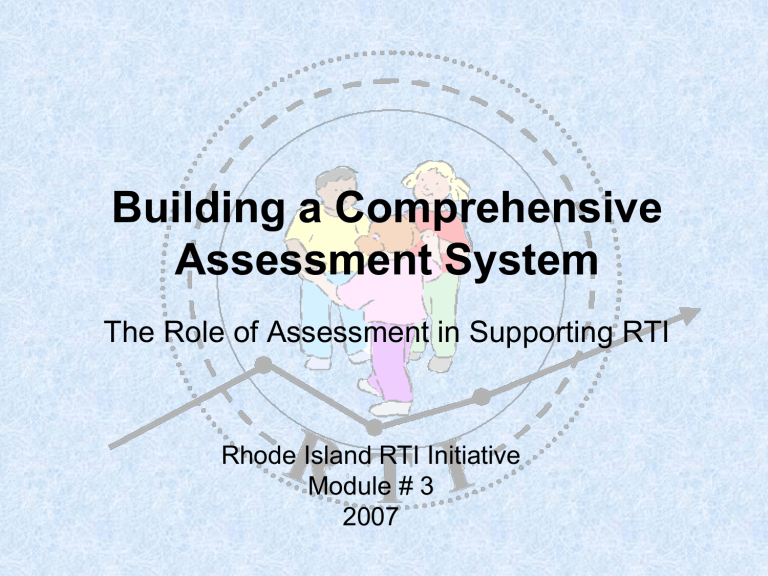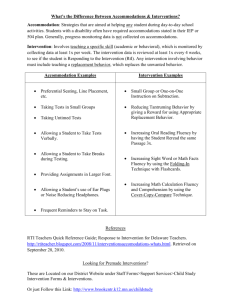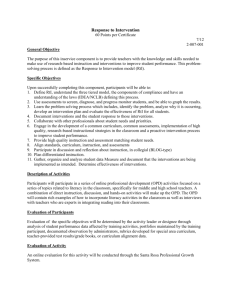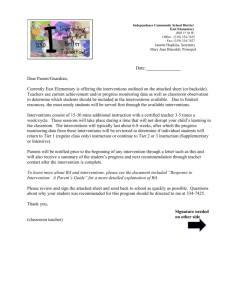RTI: An Intervention System

Building a Comprehensive
Assessment System
The Role of Assessment in Supporting RTI
Rhode Island RTI Initiative
Module # 3
2007
A coordinated system of supports for all students
• What is it?
• A problem-solving process
• A school-wide instruction and intervention system
• A way to make data-based decisions
• A shared responsibility
• Part of the special education, personal literacy plan and secondary reform process
Goals of Session
Participants will gain a deeper understanding of the following:
• Assessment data drives instruction and intervention decisions.
• Assessment ensures that progress is being made
(individual student, classroom, school, and district).
• Assessment gives teachers and students frequent and useful feedback about learning.
What does it take to meet the needs of 100% of the students
100% of the time?
• Use assessment to drive instruction
• Use data to make important educational decisions
• Monitor student progress to inform instruction
• Use a problem solving approach to make decisions
• Intervene early
• Use a collaborative model of service delivery (shared responsibility)
• Use research-based instruction/intervention matched to students’ needs
A More Powerful Vision
“If assessments of learning provide evidence of achievement for public reporting, then assessments for learning serve to help students learn more.
The crucial distinction is between assessment to determine the status of learning and assessment to promote greater learning.”
Stiggins (2002, Phi Delta Kappan)
Turn and Talk
Activity
Jigsaw the article “Assessment Crisis: The
Absence of Assessment FOR Learning” by
Richard J. Stiggins
The purpose of this activity is to create a shared understanding among school team members of the difference between assessment for learning and assessment of learning .
Jigsaw
Assignments
• Introduction: Everyone
• The Evolution of Our Vision of Excellence in
Assessment: #1
• The Flaw in the Vision: #2
• A More Powerful Vision: #3
• Are Teachers Ready? #4
• Relevant Position Statements: #5
• Balancing Assessments of and for Learning : #6
• Anticipating the Benefits of Balance: #7
• An Action Plan: #8
Raising Student
Achievement Through
Assessment
“Summative assessment requires that teachers (or other assessors) become members of a community of practice, while formative assessment requires that the learners become members of the same community of practice.”
Dylan Wiliam
Kinds of Assessment
Outcome Measurement
• Provides data about what has been accomplished over a period of time
• Provides broader information about programs and student learning
Screening
• Predicts which students are likely to experience difficulty
• Identifies students who are at-risk and in need of further diagnostic assessment
RIDE PreK-12 Literacy Policy December 2005
Kinds of Assessment
Diagnostic Measurement
• Provides more precise and indepth analysis of a student’s strengths and weaknesses
• Determines more specifically problematic areas for the student
• Pinpoints needs and helps determine appropriate interventions
Progress Monitoring
• Informs the teacher about a student’s progress
• Determines if the student is making progress
• Provides timely measures to inform instruction
RIDE PreK-12 Literacy Policy December 2005
What is the purpose of each kind of assessment?
Turn and Talk
Of Learning For Learning
What types of assessments does your school/district currently use?
Activity: Identify the name and type of assessments used by your district in the area of literacy. Align each assessment with the GLE
Content Cluster each assesses.
Example: The GRADE is a screening and diagnostic measure in the areas of vocabulary and comprehension.
Grades:
__________
Phonemic
Awareness
□ Accuracy
□ Rate
Expression
Word
Identification
□ Phonics
□ Spelling
□ Structural
Analysis
Fluency
□ Accuracy
□ Rate
□ Expression
Vocabulary
□ Word learning strategies
□ Breadth of vocabulary
Comprehension
□ Literary
□ Informational
□ Self-monitoring
□ Reading
Strategies
□ Breadth of Rdg
Writing
□ Habits of
□ Structures of Lang
□ Conventions o Grammar o Spelling
Writing Genres
□ Response to Lit
□ Report Writing
□ Procedural
□ Narrative
□ Persuasive (6+)
Core
Curriculum
ALL KIDS
Targeted/
Strategic
Interventions
SOME KIDS
Intensive
Interventions
FEW KIDS
OUTCOME/SCREENING
DISTRICT/CLASSROOM PROGRESS MONITORING
DIAGNOSTIC
INTERVENTION/PROGRESS MONITORING
DIAGNOSTIC
INTERVENTION/PROGRESS MONITORING
Grades:
__________
Phonemic
Awareness
□ Accuracy
□ Rate
Expression
Word
Identification
□ Phonics
□ Spelling
□ Structural
Analysis
Fluency
□
Accuracy
□
Rate
□ Expression
Vocabulary
□
Word learning strategies
□
Breadth of vocabulary
Comprehensio n
□ Literary
□ Informational
□ Self-monitoring
□ Reading
Strategies
□ Breadth of Rdg
Writing
□
Habits of
□
Structures of
Lang
□
Conventions o Grammar o Spelling
Writing
Genres
□ Response to Lit
□ Report Writing
□ Procedural
□ Narrative
□ Persuasive (6+)
Core
Curriculum
ALL KIDS
Targeted/
Strategic
Interventions
Phonemic
Awareness
Test
SOME KIDS
Intensive
Interventions
FEW KIDS
CTOPP
Running
Records
Developme ntal
Spelling
Inventory
TOWRE Oral
Reading
Fluency
–
Aimsweb
Oral
Reading
Fluency
–
Aimsweb
Response To
Intervention is …
the practice of providing high-quality instruction and interventions matched to student need, monitoring progress frequently to make decisions about instruction so that we meet the needs of
100% of the students 100% of the time.
Adapted from: National Association of State
Director’s of Special Education (2005)
Monitoring Progress
Frequently
Grouping students for instruction based on student skill, monitoring their progress over small periods of time, adjusting instruction based on the data and providing kids feedback on their performance… one of the most powerful sets of educational practices that exists.
Dan Reschly
THREE LEVELS OF PROGRESS
MONITORING:
District/School: provides evidence to make informed district/school decisions for resource allocations, professional development planning/ implementation, program planning and evaluation.
Classroom: is on-going and includes tasks typically used during the instructional process (curriculum embedded). It measures student’s learning based on systematic observation and guides the specifics of instruction within the curriculum.
Intervention: occurs frequently (weekly, bi-weekly, monthly) for students with intervention plans. The results of this type of progress monitoring inform instructional decisions (e.g. the PLP process is used for reading interventions) and shows the effectiveness of the interventions.
Intervention progress monitoring using CBM
• Are assessments to monitor progress
• Are designed to serve as “indicators” of academic achievement.
• CBM doesn’t measure everything, but measures the important things.
• Are sensitive to improvement in short periods of time.
• Are designed to be as short as possible to ensure
“do-ability”.
• Are curriculum-independent.
Characteristics of CBM
• Standardized
• Enable multiple forms
• Inexpensive
• Quick and easy to administer
• Rely on visual displays of the information to determine progress and make instructional decisions
Math Computation
Taken from
Fuchs, L. S.,
Hamlett, C. A.,
& Fuchs, D.
(1998).
Monitoring
Basic Skills
Progress: Basic
Math
Computation
(2nd ed.).
[computer program].
Austin, TX:
ProEd.
Available: from http://www.pro
edinc.com
Research Indicates:
• CBM produces accurate, meaningful information about students’ academic levels and growth;
• When teachers use CBM to inform their instructional decisions, students achieve better.
Charting Progress
Monitoring Results
CBM
50
40
30
20
10
0
1 2 3 4 5 6
Session
7 8 9 10 11
How do we know if the Intervention is working?
AND…
How do we use these data to make decisions?
Action Planning
• What does our school need to do differently to make assessment effective in the Response to Intervention (RTI) process and to meet the needs of all learners all of the time?
Action Planning
If you’re not hopelessly confused, you’re out of touch!
If you are hopelessly confused, then you only have one choice
— try stuff.
Tom Peters, Embracing Chaos , 1993





